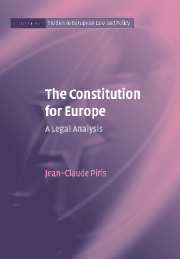Book contents
- Frontmatter
- Contents
- List of figures
- List of tables
- List of boxes
- Series editors' preface
- Acknowledgments
- Table of cases
- List of annexes
- Introduction
- 1 Is The constitution for Europe ‘dead and buried’?
- 2 The process that led to the Constitution
- 3 Changes in structures and procedures
- 4 Changes in the institutions
- 5 Changes in substance
- 6 General Assessment
- Conclusion what will the final form of the union be?
- List of annexes
- Table of equivalences between the provisions of the Treaty establishing a Constitution for Europe and the provisions of the EU and EC Treaties
- List of ‘passerelles’ and provisions on a simplified revision procedure
- Table of references
- Index
3 - Changes in structures and procedures
Published online by Cambridge University Press: 04 August 2010
- Frontmatter
- Contents
- List of figures
- List of tables
- List of boxes
- Series editors' preface
- Acknowledgments
- Table of cases
- List of annexes
- Introduction
- 1 Is The constitution for Europe ‘dead and buried’?
- 2 The process that led to the Constitution
- 3 Changes in structures and procedures
- 4 Changes in the institutions
- 5 Changes in substance
- 6 General Assessment
- Conclusion what will the final form of the union be?
- List of annexes
- Table of equivalences between the provisions of the Treaty establishing a Constitution for Europe and the provisions of the EU and EC Treaties
- List of ‘passerelles’ and provisions on a simplified revision procedure
- Table of references
- Index
Summary
The Constitution will restructure the existing texts of the Treaties, streamline legal instruments and procedures and codify long‐standing principles and rules, so as to try and make these texts more consistent and easier to read for the users.
Up to the Constitution, the original Treaties from 1957 had been amended 15 times. As a result, there are at present about 2800 pages of primary law contained in 17 Treaties or Acts, three legal personalities, three so‐called ‘pillars’, 15 types of different legal instruments and several types of decision‐making procedures. Restructuring all this and trying to make it more readable was long‐needed.
This restructuring is the most visible and, in a way, the most revolutionary work achieved by the Convention and the IGC. The choice was made to repeal all existing Treaties and to replace them by the single, restructured, text of the Constitution. This choice entails the re‐ratification by Member States of all those existing, and often old, provisions which have been recopied without any substantial changes for the Rome Treaty into the Constitution. This re‐ratification opens the political opportunity for Euro‐sceptics of all kinds to criticise one or other provision of the present Treaties, claiming that it confers a new competence on the Union, whereas in reality it has been existing for a long time and has been already ratified in the past.
- Type
- Chapter
- Information
- The Constitution for EuropeA Legal Analysis, pp. 56 - 86Publisher: Cambridge University PressPrint publication year: 2006

